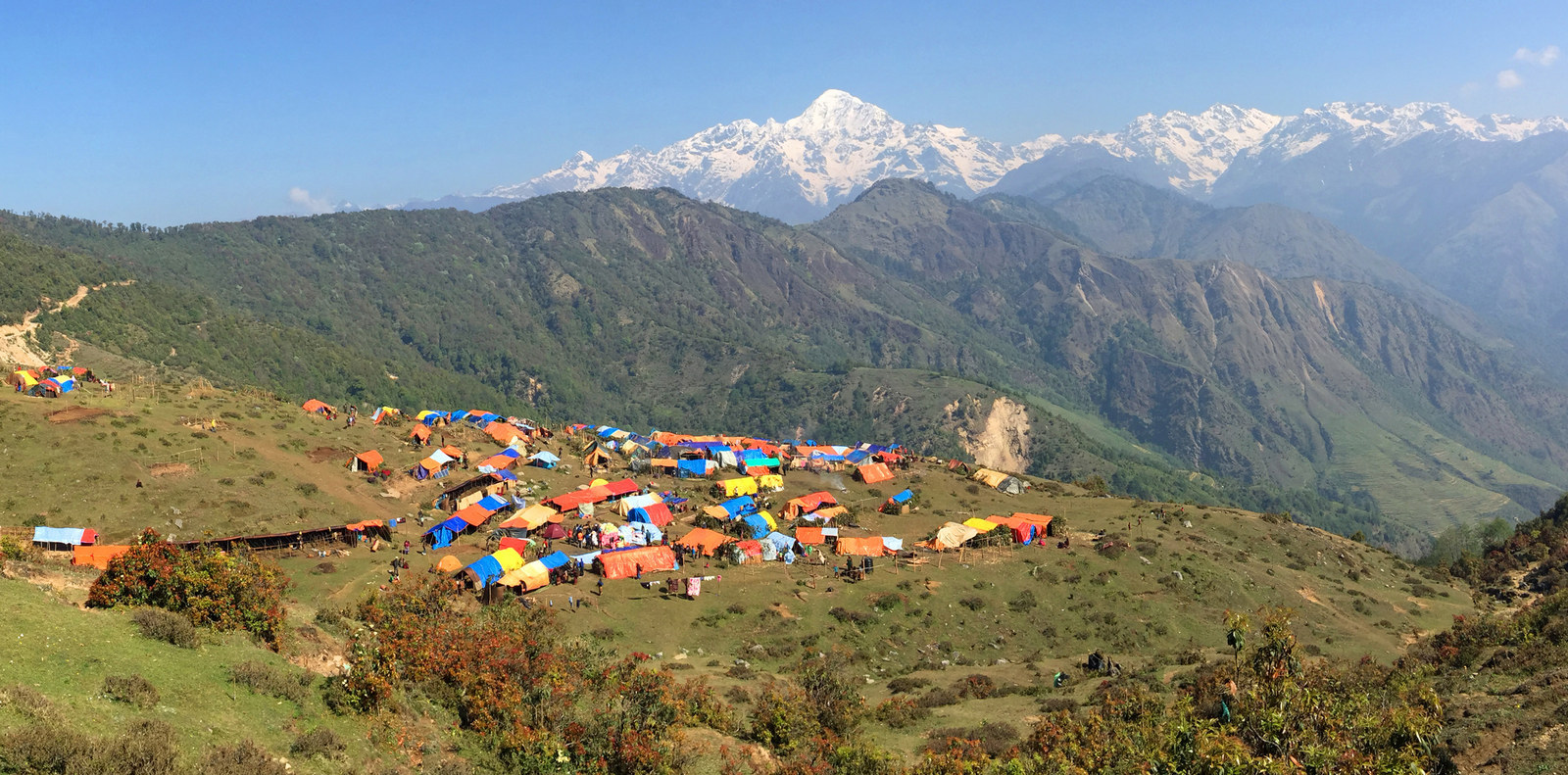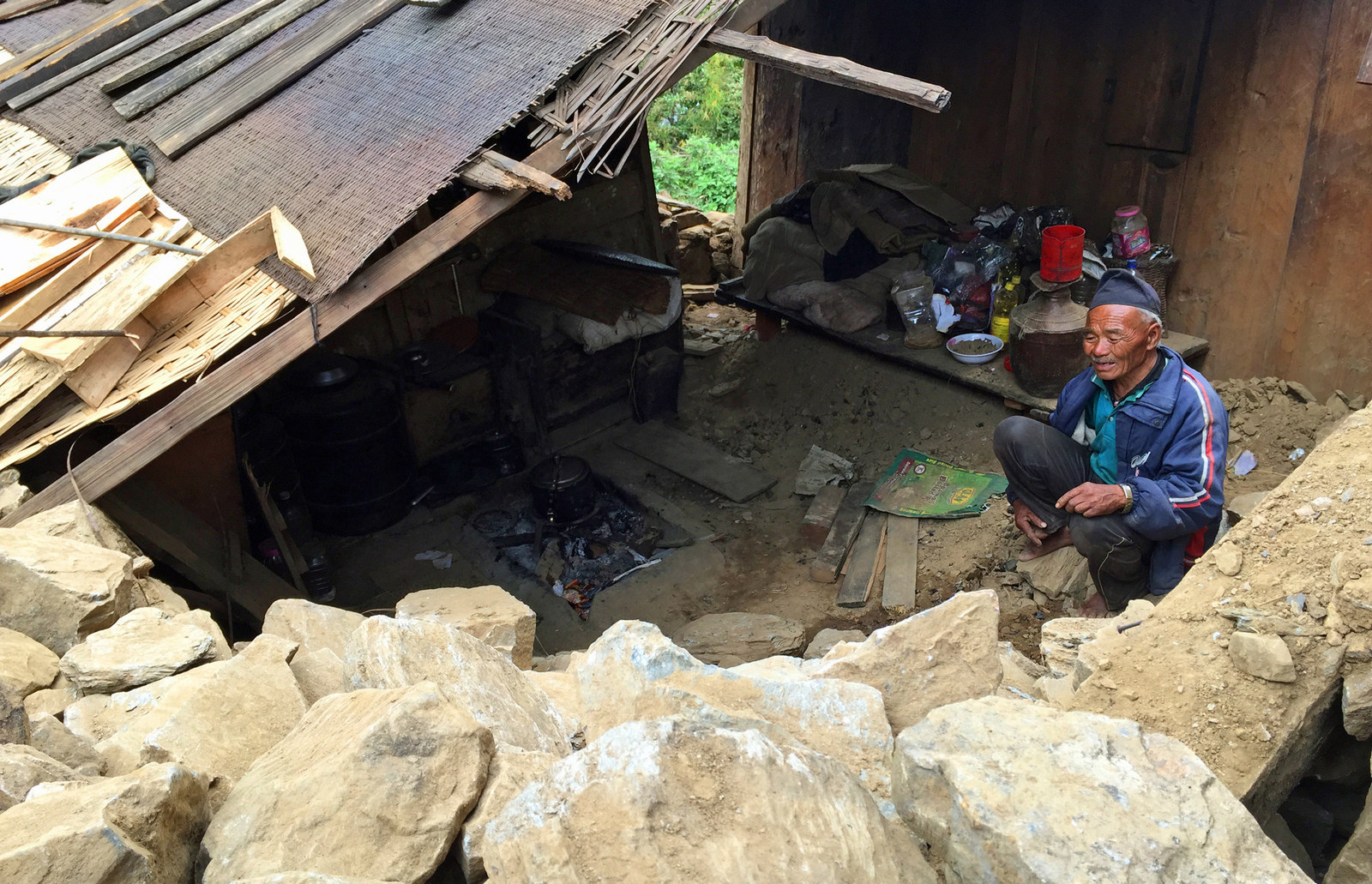LAPRAK, Nepal — It was a quiet Saturday in Laprak. With the village’s only school closed, some kids were playing on yellow terraced wheat fields. As afternoon neared, clouds hovered over the hills, halfway blocking the view of Buddha Himal, a sacred mountain in the Himalayan range in the western Gorkha region.
Dambar Bahadur Gurung, 68, had just walked up a hill to a dense rhododendron forest to graze his five goats when the earth beneath him suddenly started shaking.
At first, the steep hills across the village rumbled and rocks fell slowly.
Then, suddenly, great pockets of dust rose from between the trees, as if someone had detonated a grenade, and then another, and then another.
Soon thereafter, the entire village looked as if it had been swallowed by a giant sandstorm. Within minutes, the village of nearly 600 homes was reduced to slabs of broken bamboo, stones, and chunks of dry mud.
Laprak was near the epicenter of the catastrophic 7.8-magnitude earthquake that walloped Nepal three weeks ago, the worst earthquake in almost a century. More than 8,300 people have been killed and more than half a million have been made homeless. The country’s finance minister has said that rebuilding damaged infrastructure and homes, including historic monuments and temples, will cost more than $2 billion. BuzzFeed News was one of the first outlets to visit the village, and spoke to around 50 villagers whose houses were destroyed by the earthquake, and about half a dozen families who lost loved ones.

As the dust covered the village, women frantically screamed for their children. A cell phone video taken by one of the villagers showed one child grab another’s hand and crawl up the terraced wheat fields — but the ground underneath started cracking along the narrow ridge.
“This must be the gods ending the earth,” Dambar Bahadur thought. He threw down his walking stick, gathered his goats, and bolted toward home to find his wife. When he was halfway there, he suddenly remembered his daughter.
Sher Maya Gurung, 37, was his only child and had crossed the river to collect firewood that morning, as she did every weekend morning, since her parents were too old to do it themselves. When the earthquake struck, she began to run, but was struck by a rock that tumbled down from a hill. It smashed her forehead and split the top of her head, killing her.
In Laprak’s tight-knit community, nearly everyone knows families who have lost someone in the earthquake, and survivors are struggling to both come to terms with what they’ve lost and to think of how to rebuild.
Laprak is one of the most picturesque villages in Nepal, tucked into the lap of giant Himalayan mountains, which were formed nearly 50 million years ago as a result of the collision between two seismic plates that continue to shift and collide, building up energy and then releasing it in the form of earthquakes.
The village is predominantly home to the Gurung community, an ethnic group that comprises nearly 3.5 million people spread across the rugged terrain of western Nepal. Gurungs have their own language and traditions and are known in Nepal as being particularly strong and brave. Traditionally they work as sheep and goat herders, but for the last 200 years many have been serving in the British Gurkha regiment and now others work as mountain guides and trekking porters.
Many older residents have never left the village of 4,300. “For my grandfather and a lot of villagers, Laprak was a country itself,” said Purna, a 32-year old trekking guide from Laprak. “Whenever my vacation was over and I had to leave the village, he would ask me: ‘Are you going back to Nepal?’”
Purna’s grandfather, an 83-year-old lama who conducted shamanistic rituals in the village, has not been seen since the earthquake. Five days after it struck, villagers found a walking stick believed to be his. Some say he may have been washed away in the Tharo river after a landslide.

Shurman Gurung was building a house when the earthquake struck. He heard something that sounded like an explosion, turned his head to look outside through an unfinished window frame, and saw billows of dust heading toward him. Seconds later, the house was no longer standing. His wife, Pasmaya, was in their home knitting a shawl when a wooden door collapsed and fell on her, pressing her against the crumbling stone wall behind her. She tried to free herself, but a nail from a broken piece of window beam pierced into her back. She shrieked.
They both lived, but their 18-year old daughter, Churkela, suffered a different fate. She had gone to the forest to cut bamboo with six other girls from the village when the earthquake struck. As the seven of them ran away, Churkela slipped on a landslide. She was dragged downhill and died.
Yug Gurung, a trained mountain guide, had just finished lunch at a café on a trekking trail several days’ walk away from his home in Laprak along with 11 trekking companions when the earthquake struck. They all headed toward Pokhara, a popular tourist destination a few hours from Gorkha and about a six-hour drive from Kathmandu, when he received a phone call from his brother-in-law in Riyadh.
“Are you OK?” he asked.
“Yes,” Yug replied.
“Do you know what happened in the village?”
“No.”
“Your house fell down and your younger brother was killed.”
Yug’s younger brother, Roshan, was 15 and had just finished sixth grade. His body was only found after three days. “God took away my brother,” he said.
The earthquake killed more than 8,300 nationwide, making it one of the worst tragedies in the country’s history. In Laprak, 18 people died, half of them children. Subsequent aftershocks — there have been nearly 170 recorded since the big earthquake struck on April 25 — have made distributing aid and building shelters a challenging task. The earth’s crust showed no signs of resting.
Prime Minister Sushil Koirala was in transit in Bangkok on his way back from Jakarta when the earthquake struck. He tried to return to Kathmandu, but was stranded since Nepal’s only international airport had been shut down. He later issued a statement saying that the government would provide relief to all Nepalis.
Two weeks later, Koirala took a white helicopter formerly used by the king and landed at a makeshift helipad in Laprak. It was the first time Laprak’s residents ever saw a national leader. He reassured them that the government would slowly give each and every one relief aid, and then he flew away.
“He was here for less than 30 minutes,” said Marsingh Gurung, a village elder who has put himself in charge of overseeing relief materials that come to Laprak.
Since then, the Nepal army, which has one big helicopter, has worked with the Indian air force to ferry aid to Laprak, including sacks of rice, noodles, salt, beaten rice, biscuits, and lentils. It has not always gone smoothly — one day, the helicopter dropped all its supplies off in another village by mistake, so a group of villagers walked five hours to get there and returned with sacks of rice on their backs.

The last time Laprak received attention on a national scale was in 1999, when a heavy rain that lasted 24 hours triggered a landslide and destroyed dozens of homes. Since then, Laprak has had access to a drivable gravel road that connects it with Abu Khaireni, a town on the major highway that runs to Kathmandu.
Those roads have been blocked again since the earthquake, as rocks tumbled down the hills. With no access to roads, villagers in Laprak didn’t get help for days until the government started flying helicopters, first to survey the damage, and later to drop relief supplies.
But for almost two weeks after the killer quake, villagers here did not see a single grain of rice.
In the hours after the earthquake, villagers gathered whatever they could — aluminum pots, ladles, jute ropes — on a doko, a V-shaped basket woven from dry bamboo shoots, and walked, many of them barefoot, for two hours until they reached Gupsi Dada, one of the higher hills that hadn’t cracked from the earthquake.
Shurman and Pasmaya, whose daughter Churkela had died in the quake, went to look for her body after the aftershocks had subsided on April 28. They found her and tied her to a flat plank of wood and carried it to one of two graveyards in the village. After burying their daughter, they walked up to Gupsi Dada with rest of the villagers.
Their one-bedroom home was now unlivable and the upper floor bhakari where they stored maize and wheat was smashed into rubble, all of the food now useless. Among their smashed possessions were pots and pans, and a dingy aluminum steamer, which Churkela had used to cook momos, a traditional Nepali dumpling made with spices and minced meat.
“She made really good fried potatoes and very delicious momos,” Shurman recalled. “She said she wanted to run a momo restaurant one day.” With little available to eat now, the only thing Churkela’s parents could do was think about their daughter’s food.
The government had doled out a ration of six packets of noodles and five packets of biscuits. “We need blankets,” Shurman said. “It’s cold and it is going to rain soon.”
Villagers run up to the helipad whenever a helicopter lands, expecting to receive something, anything.
Not everyone, however, is joyous about the rice.
“I don’t feel like eating,” said Dambar Bahadur, whose eyes have been swollen from crying since the day he saw his daughter’s bloodied body in the debris.
During the decade-long armed conflict between Maoist guerrillas and Nepal’s army from 1996 to 2006, Dambar Bahadur would walk for five days to the bazaar in Gorkha to buy food for his family. That morning, he hardly wanted to think about it.
He wiped his tears with his cracked, dry palms and stared at his wife. Rivulets of tears ran down her face.
He said, “How do we cook this rice if we don’t have our daughter to bring us firewood?”
